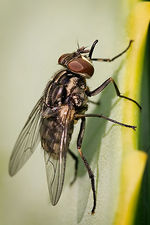Difference between revisions of "Stomoxys calcitrans"
Jump to navigation
Jump to search
| (24 intermediate revisions by 3 users not shown) | |||
| Line 1: | Line 1: | ||
| − | {{ | + | {{review}} |
| − | + | ||
| − | + | [[Image:Stomoxys calcitrans.jpg|thumb|right|150px|''Stomoxys calcitrans'' - Wikimedia Commons]] | |
| − | + | ==Also known as== | |
| − | + | ||
| − | + | <big>'''Stable fly'''</big> | |
| − | + | ||
| − | + | *'''Visiting''' biting fly | |
| − | + | **Feeds on the host | |
| − | + | **Spends most of its time '''off''' the host e.g. In flight or resting on buildings, foliage and fences | |
| − | + | ||
| − | + | *Attacks most animals | |
| − | + | ||
| − | + | *Found worldwide | |
| − | [[Image:Stomoxys calcitrans.jpg | + | |
| − | Also known as | + | |
| + | ==Recognition== | ||
| + | *Similar to [[Musca spp.|''Musca domestica'']] | ||
| + | |||
| + | *5-7mm long | ||
| + | |||
| + | *Forward-pointing proboscis (biting) | ||
| − | + | **Both males and females suck blood | |
| − | |||
| − | + | *Grey thorax and abdomen | |
| − | + | *Longitudinal grey stripes on thorax | |
| − | |||
| − | |||
| − | + | *Large black spots on abdomen | |
| − | + | *Clear wings | |
==Life cycle== | ==Life cycle== | ||
| − | Eggs | + | *Eggs laid on rotting hay and straw |
| − | + | *Larvae feed on vegetable matter | |
| − | + | *Life cycle takes '''1 month''' | |
| − | + | *Adult flies survive for 1 month | |
| − | |||
| − | |||
| − | + | ==Pathogenesis== | |
| + | *Production losses | ||
| + | **Reduced weight gain | ||
| + | **Milk yield losses | ||
| + | ***Up to 20% in cattle affected by '''fly worry''' | ||
| + | |||
| + | *Vectors for the retrovirus [[Equine Infectious Anemia|Equine infectious anaemia]] | ||
| + | |||
| + | *Mechanical vectors for protozoa e.g. trypanosomes in warmer countries | ||
| − | + | *Intermediate hosts of the nematode [[Parasitic skin infections - Pathology#Helminths|''Habronema'']] | |
[[Category:Biting_Flies]] | [[Category:Biting_Flies]] | ||
| − | |||
| − | |||
Revision as of 22:48, 7 April 2010
| This article has been peer reviewed but is awaiting expert review. If you would like to help with this, please see more information about expert reviewing. |
Also known as
Stable fly
- Visiting biting fly
- Feeds on the host
- Spends most of its time off the host e.g. In flight or resting on buildings, foliage and fences
- Attacks most animals
- Found worldwide
Recognition
- Similar to Musca domestica
- 5-7mm long
- Forward-pointing proboscis (biting)
- Both males and females suck blood
- Grey thorax and abdomen
- Longitudinal grey stripes on thorax
- Large black spots on abdomen
- Clear wings
Life cycle
- Eggs laid on rotting hay and straw
- Larvae feed on vegetable matter
- Life cycle takes 1 month
- Adult flies survive for 1 month
Pathogenesis
- Production losses
- Reduced weight gain
- Milk yield losses
- Up to 20% in cattle affected by fly worry
- Vectors for the retrovirus Equine infectious anaemia
- Mechanical vectors for protozoa e.g. trypanosomes in warmer countries
- Intermediate hosts of the nematode Habronema
